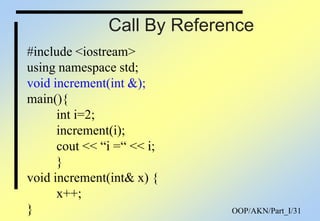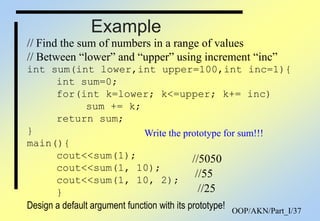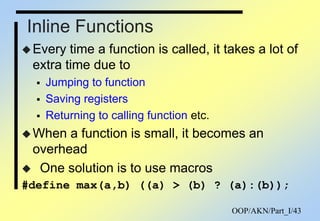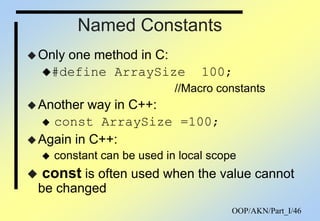Object Oriented Programming using C++ Part I
- 1. OOP/AKN/Part_I/1 Object Oriented Programming using C++ Module I Ajit K Nayak, Ph.D. SOA University, Odisha, India
- 2. OOP/AKN/Part_I/2 Contents 1. Fundamentals 2. Simple Program 3. Operators 4. Datatypes 5. Namespace 6. Function Prototypes 7. References 8. Passing Default Arguments 9. Function Overloading 10. Inline Functions 1. Named constants 2. Dynamic memory allocations
- 3. OOP/AKN/Part_I/3 Motivation OOD is the current technology for software design and development. C++ is a tool to develop programs/codes for OOP. Therefore, this subject is the bread and butter for all those are interested in Software Industry.
- 4. OOP/AKN/Part_I/4 About the Course Two Goals for this course(OO-P) Understand OO Thinking in Objects Familiar with P Programming in C++
- 5. OOP/AKN/Part_I/5 Course Description In this course: C++ is used for illustrating and implementing Object Oriented concepts.
- 6. OOP/AKN/Part_I/6 A Sample Program /*Author : Ajit K Nayak Reg #: Date: Source file: helo.cpp Desc: A Simple Hello, World Program */ #include <iostream> using namespace std; main() { /* the output statement */ cout << “Hello, World!”<<endl; }
- 7. OOP/AKN/Part_I/7 How to Write and Execute in Linux Open a file in vi / gedit with extension as .cpp or .cxx or .C Write the source code Save and exit Compile with c++ <filename> (or g++) Check for errors Execute with ./a.out Guideline:- Do write the source code in well indented format
- 8. OOP/AKN/Part_I/8 History of C and C++ C (K & R-70s) was evolved from BCPL(M. Richards-67) and B(K. Thompson-70). C++ is developed by Bjarne Stroustrup in 1980 C++ is an extension to C latest standard C++11 ISO/IEC 14882:2011 Along with C-style programming it provides capabilities for OOP
- 10. OOP/AKN/Part_I/10 Guidelines …B.Stroustrup Knowing C is not a prerequisite to learn C++ The better one Knows C, the harder it seems to be to avoid writing C++ in C-style. Suggestions for C Programmers Macros are almost never necessary Don't Declare a variable before you need it Don‟t use malloc(), use new operator Try to avoid Void*, pointer arithmetic, unions and casts Try thinking a program as a set of interacting agents represented as classes and objects …
- 11. OOP/AKN/Part_I/11 Prerequisite It is expected that you know: branching: if – else, switch-case. Loop: for, while, do- while. Array, pointer, structure, function etc. Not confident!!! Rush, pickup a C book learn and write programs on above topics.
- 12. OOP/AKN/Part_I/12 A Sample Program /*Author : Ajit K Nayak Reg #: Date: Source file: helo.cpp Desc: A Simple Hello, World Program */ #include <iostream> using namespace std; main() { //the output statement cout << “Hello, World!”<<endl; }
- 13. OOP/AKN/Part_I/13 Basic Operators- I Arithmetic operators ( +, -, *, /, % ) x = 5 % 2.5 Increment and decrement (++, --) x = 3++; Relational and comparison operators ( ==, !=, >, <, >=, <= ) x = 5 > 3; Logical operators ( !, &&, || ) Bitwise operators ( &, |, ^, ~, <<, >> ) x = 5 & 3 Compound assignment (+=, -=, *=, /=, %=, >>=, <<=, &=, ^=, |=) x = 3 * = 2
- 14. OOP/AKN/Part_I/14 Basic Operators- II Conditional ternary operator ( :? ) x = 7== 5 ? 4 : 3 ; Comma operator ( , ) a = (b=3, b+2); Explicit type casting operator int i; float f = 3.14; i = (int) f; Sizeof() x = sizeof (char); Precedence of Operators x = 5 + 7 % 2;
- 15. OOP/AKN/Part_I/15 Operators specific to C++ Stream insertion (<<) Stream extraction (>>) Dynamic memory allocation: new, new[ ] Memory de-allocation: delete, delete[ ] Scope resolution (::)
- 16. OOP/AKN/Part_I/16 Datatypes …A review C++ has a set of fundamental types Boolean type (bool) Character type (char) Integer type (int) Floating point type (float) Double precision type (double) In addition a user can define Enumeration type (enum) to represent specific set of values
- 17. OOP/AKN/Part_I/17 Data types (contd.) There also is A type void used to signify the absence of data From these above types we can construct Pointer type (*) Array type ([ ]) Reference type (&) Finally the most powerful user-defined types Data structures and classes(struct, class)
- 18. OOP/AKN/Part_I/18 A Classification Boolean, character, and integer types are collectively called as integral types Floating point types are called arithmetic types Pointer, reference, and array are called associated/derived types All of the above are built-in types Enumerations, structures, and classes are called user defined types
- 19. OOP/AKN/Part_I/19 Boolean Type A bool can have one of the two values; true or false It is used to express the results of logical expressions Example: bool b1=a==b; b1=true ->if a and b are of same value = false -> otherwise bool greater(int a, int b){ return a>b; } True has the value 1 and false has 0
- 20. OOP/AKN/Part_I/20 Boolean Type(contd) Nonzero integers convert to true and 0 to false More Examples bool b = 7; // b is true int i = true // i=1 bool x = a+b // true if …. bool y = a|b // true if a or b is true if (b) // if b is true What is the size required to store a certain type?
- 21. OOP/AKN/Part_I/21 Example program int main(){ cout << "char: " << sizeof(char) << endl; cout << "short: " << sizeof(short) << endl; cout << "int: " << sizeof(int) << endl; cout << "unsigned int: " << sizeof(unsigned int) << endl; cout << "long int: " << sizeof(long int) << endl; cout << "unsigned long int: " <<sizeof(unsigned long int)<< endl; cout << "float: ” << sizeof(float)<<endl; cout << "double: " << sizeof(double) << endl; cout << "long double: " << sizeof(long double) << endl; cout << "bool: " << sizeof(bool) << endl; }
- 22. OOP/AKN/Part_I/22 Namespace What is scope of a variable? Outer Block { int x=10; … { int x=20; … } … } Inner Block How to access outer’s x and Inner’s x? If I can name the blocks!
- 23. OOP/AKN/Part_I/23 Namespace contd. C++ namespaces can be used to group names together. (give a name to a block) It provides a mechanism for expressing logical grouping. If some declarations logically belong together according to some criteria, they may be put in a common namespace To use a namespace member, the member name must be qualified with a namespace name and the binary scope resolution operator (namespace_name::member)
- 24. OOP/AKN/Part_I/24 Namespace contd. namespace outer{ int x=10; namespace inner{ int x=20; } } Scope resolution Operator If there is a global variable??? main(){ int x=0; cout<<“self "<<x; cout<<"Out "<<outer::x; cout<<"In "<<outer::inner::x; }
- 25. OOP/AKN/Part_I/25 Namespace Contd. namespace mySpace{ int x=20; int y=30, int z=40; } To use these variables! cout<< mySpace::x; cout<< mySpace::y; cout<< mySpace::z; Another Way using namespace mySpace; cout<<x; cout << y; cout << z; Note: cout and cin objects are declared in predefined namespace „std‟ Either write using namespace std; or std:: cout, std::cin etc.
- 26. OOP/AKN/Part_I/26 Function Prototype main(){ int x = 5; float y = 10.65; doTask(x, y); } //end of main void doTask(int a, float b){ cout <<a+b<<„n‟ ; }//end of function void doTask(int a, float b); Syntax: • return_type <function_name>(data type of input parameter list separated by comma ); • It can be called as function declaration • It is used at the time of compilation to check if the return value is handled correctly and correct number and type of arguments are passed to the function • Never use a function without a prototype
- 27. OOP/AKN/Part_I/27 Call By Value #include <iostream> using namespace std; void increment(int); main() { int i=2; increment(i); cout << “i = “ << i; } void increment(int x) { x++; } OUTPUT ? Explain!
- 28. OOP/AKN/Part_I/28 References It is an alternative name for an object It is used to specify arguments and return values for functions in general and for overloaded operators Example int i=1; int& ir=i; int x=ir; ir=2; //ir and i now refers to same value // x=1 // i = 2
- 29. OOP/AKN/Part_I/29 References(contd.) To ensure that a reference is a name for something( bound to an object), we must initialize the reference Example: int i=1; int& r2; Int& r1=i //Error: initialization missing //OK: r1 is now an alias for i
- 30. OOP/AKN/Part_I/30 Pointers and References int ii = 0; int& rr=ii; rr++; int *pp=&rr // or &ii 0 ii: &ii pp: rr: • pp is a variable which stores address of another variable • rr is an alternative name (alias) for an existing variable • The value of a reference cant be changed after initialization. It always refers to the same object it was initialized. Which is not the case in pointers
- 31. OOP/AKN/Part_I/31 Call By Reference #include <iostream> using namespace std; void increment(int &); main(){ int i=2; increment(i); cout << “i =“ << i; } void increment(int& x) { x++; }
- 32. OOP/AKN/Part_I/32 Example2 #include <iostream> using namespace std; int max(int&, int&); main(){ int i=2,j=3; cout<<max(i,j); } int max(int& x, int& y){ return x>y ? x:y; } Output?
- 33. OOP/AKN/Part_I/33 Example3 #include <iostream> using namespace std; int& max(int&, int&); main(){ int i=2,j=3; int &p=max(i,j);cout<<p; p=-30; cout<<“i=“<i<„t‟<<“j=“<<j<<„t‟<<“p=“<<p <<endl; } int& max(int &x, int &y){ return x>y ? x:y; } Output?
- 34. OOP/AKN/Part_I/34 References contd. Calls to functions that returns reference can be put on the left side of the assignment operator. main(){ int i=2,j=3; max(i,j)= -30; cout<<“i=“<i<„t‟<<“j=“<<j<<„t‟<<endl; } The value –30 will be assigned to the larger of i & j
- 35. OOP/AKN/Part_I/35 Use of passing by reference To manipulate original values of variables inside a function To pass large objects To return more than one value from a function (virtually) To use a function to the left side of = operator Any other, you may suggest!
- 36. OOP/AKN/Part_I/36 Default Arguments Parameters can be assigned default values. Parameters assume their default values when no actual parameters are specified for them in a function call. A default argument is type checked at the time of function declaration and evaluated at the time of call Default arguments may be provided for trailing arguments only
- 37. OOP/AKN/Part_I/37 Example // Find the sum of numbers in a range of values // Between “lower” and “upper” using increment “inc” int sum(int lower,int upper=100,int inc=1){ int sum=0; for(int k=lower; k<=upper; k+= inc) sum += k; return sum; } main(){ cout<<sum(1); cout<<sum(1, 10); cout<<sum(1, 10, 2); } Design a default argument function with its prototype! //5050 //55 //25 Write the prototype for sum!!!
- 38. OOP/AKN/Part_I/38 Function Overloading A function is said to be overloaded when the same function name is used for different purposes. It allows you to use the same name for different functions void print(char); void print(float); Thus to overload a function we require to pass different types of arguments to each function with same name.
- 39. OOP/AKN/Part_I/39 Function Overloading(contd) Compiler decides the function to be invoked using a series of criteria in order 1. Exact match i.e. vol(5); int vol(int) 2. Match using integral promotions i.e. char to int, float to double etc. 3. Match using standard conversions i.e. int to double, double to long double 4. Match using user-defined conversions i.e. conversion between user-defined types 5. Match using the ellipsis (…) i.e unspecified number of arguments
- 40. OOP/AKN/Part_I/40 Function Overloading(contd) If more than one match is found, the call is rejected by the compiler as ambiguous Example void print(int); void print(const char*); void print(double); void print(long); void print(char);
- 41. OOP/AKN/Part_I/41 Function Overloading(contd) void h(char c, int i, short s,float f){ print(c); print(i); print(s); print(f); print(„a‟); print(49); print(0); print(“a”); } // Exact match: print(char) // Exact match: print(int) // integral promotion:print(int) // integral :print(double) // Exact match: print(char) // Exact match: print(int) // Exact match: print(int) // Exact :print(const char*)
- 42. OOP/AKN/Part_I/42 Function Overloading(contd) Overloading solely on return value is not allowed in C++ i.e. you cannot write void f(); int f(); Task Overload a function add( arg1, arg2) s.t. when both are integers and doubles it produces the addition result, when both are strings it produces another string by concatenating both .
- 43. OOP/AKN/Part_I/43 Inline Functions Every time a function is called, it takes a lot of extra time due to Jumping to function Saving registers Returning to calling function etc. When a function is small, it becomes an overhead One solution is to use macros #define max(a,b) ((a) > (b) ? (a):(b));
- 44. OOP/AKN/Part_I/44 Inline functions (contd.) But macros has various disadvantages(?) An alternative in C++ is to use inline functions: inline int max(int a, int b) { return (a > b ? a : b); } An Inline function is a function that is expanded in line when invoked. The compiler inserts the equivalent function code at the place of invocation
- 45. OOP/AKN/Part_I/45 Macro vs Inline function #define square(x) x*x main(){ cout<<square(3+2); int y=3; cout<<square(++y); } • Both fails, as macro is a blind replacement of statements. • Unlike macros, inline functions may be declared any where in the program
- 46. OOP/AKN/Part_I/46 Named Constants Only one method in C: #define ArraySize 100; //Macro constants Another way in C++: const ArraySize =100; Again in C++: constant can be used in local scope const is often used when the value cannot be changed
- 47. OOP/AKN/Part_I/47 Examples of Using const const int count = 5; static const float average = 0.5; const float f; //error!, invalid! extern const float f; //ok, extern linkage const int c3=myFunc(3); //ok, don‟t know the //value at compile time const int* p=&c2; //need to allocate space for c2 void (const int* p) { //cant modify *p here } const int myFunc(int) // ok, but no use
- 48. OOP/AKN/Part_I/48 Dynamic Memory Allocation In C we write (for a single value) int* ip; ip = (int*)malloc(sizeof(int) ); … free (ip); In C++ we will write int* ip; ip = new int; ... delete ip;
- 49. OOP/AKN/Part_I/49 Dynamic Memory Allocation In C we write (for multiple values) int* ip; ip = (int*)malloc(sizeof(int) * 100); … free ip; In C++ we will write int* ip; ip = new int[100]; ... delete [ ] ip;
- 50. OOP/AKN/Part_I/50 New/Delete opearators int* p=new int; delete p; int* p=new int(25);delete p; int* p=new int[25];delete []p; Task Find a method to declare a multi-dimensional array using new operator
- 51. OOP/AKN/Part_I/51 Memory Leak Memory leak: when you do not free a block of memory allocated with the new operator or when you make it impossible to do so. As a consequence your application may eventually run out of memory and may even cause the system to crash. void func(){ char *ch; ch = new char[100]; }
- 52. OOP/AKN/Part_I/52 Dangling Pointer Dangling pointer points to memory that has already been freed. The storage is no longer allocated. Trying to access it might cause a Segmentation fault. 1. char* func() { char str[10]; strcpy(str,"Hello!"); return(str); } 2. int *c = new int; delete c; *c = 3;
- 53. OOP/AKN/Part_I/53 Readings Programming Bjarne Stroustrup, The C++ Programming Language, PE Lippman, Lajoie, C++ Primer, Addison-Wesley B. Eckel, Thinking in C++, Vol I and Vol II Deitel & Deitel, C++ How to program Schildt, C++ The complete reference S. Sahay, OOP with C++ E. Balagurusami, Object oriented programming with C++ Concepts G.Booch, Object Oriented Analysis & Design Bertand Meyer, Object Oriented Software Construction















![OOP/AKN/Part_I/15
Operators specific to C++
Stream insertion (<<)
Stream extraction (>>)
Dynamic memory allocation: new, new[ ]
Memory de-allocation: delete, delete[ ]
Scope resolution (::)](https://image.slidesharecdn.com/oopwithcparti-170525093928/85/Object-Oriented-Programming-using-C-Part-I-15-320.jpg)

![OOP/AKN/Part_I/17
Data types (contd.)
There also is
A type void used to signify the absence of data
From these above types we can construct
Pointer type (*)
Array type ([ ])
Reference type (&)
Finally the most powerful user-defined types
Data structures and classes(struct, class)](https://image.slidesharecdn.com/oopwithcparti-170525093928/85/Object-Oriented-Programming-using-C-Part-I-17-320.jpg)































![OOP/AKN/Part_I/49
Dynamic Memory Allocation
In C we write (for multiple values)
int* ip;
ip = (int*)malloc(sizeof(int) * 100);
…
free ip;
In C++ we will write
int* ip;
ip = new int[100];
...
delete [ ] ip;](https://image.slidesharecdn.com/oopwithcparti-170525093928/85/Object-Oriented-Programming-using-C-Part-I-49-320.jpg)
![OOP/AKN/Part_I/50
New/Delete opearators
int* p=new int; delete p;
int* p=new int(25);delete p;
int* p=new int[25];delete []p;
Task
Find a method to declare a multi-dimensional
array using new operator](https://image.slidesharecdn.com/oopwithcparti-170525093928/85/Object-Oriented-Programming-using-C-Part-I-50-320.jpg)
![OOP/AKN/Part_I/51
Memory Leak
Memory leak:
when you do not free a block of memory allocated with
the new operator
or when you make it impossible to do so.
As a consequence your application may
eventually run out of memory and may even
cause the system to crash.
void func(){
char *ch;
ch = new char[100];
}](https://image.slidesharecdn.com/oopwithcparti-170525093928/85/Object-Oriented-Programming-using-C-Part-I-51-320.jpg)
![OOP/AKN/Part_I/52
Dangling Pointer
Dangling pointer points to memory that has
already been freed. The storage is no longer
allocated. Trying to access it might cause a
Segmentation fault.
1. char* func() {
char str[10];
strcpy(str,"Hello!");
return(str);
}
2. int *c = new int; delete c;
*c = 3;](https://image.slidesharecdn.com/oopwithcparti-170525093928/85/Object-Oriented-Programming-using-C-Part-I-52-320.jpg)
